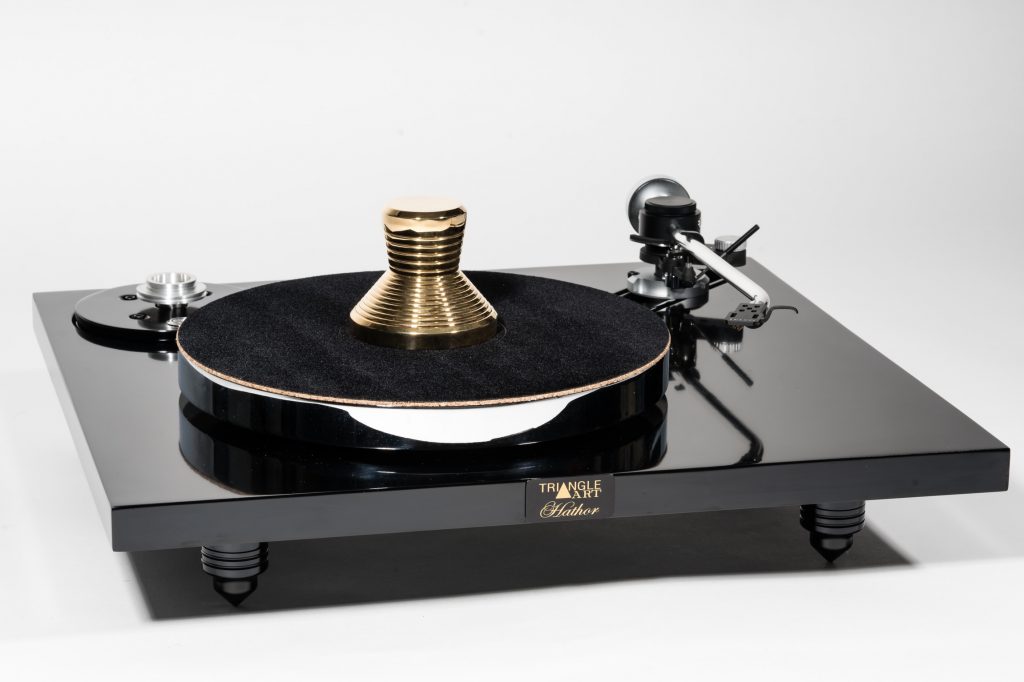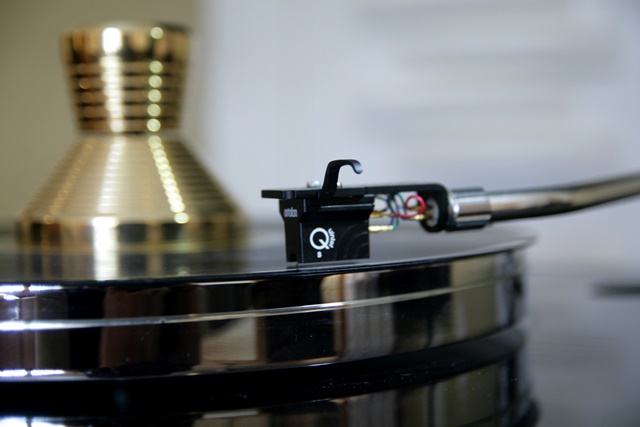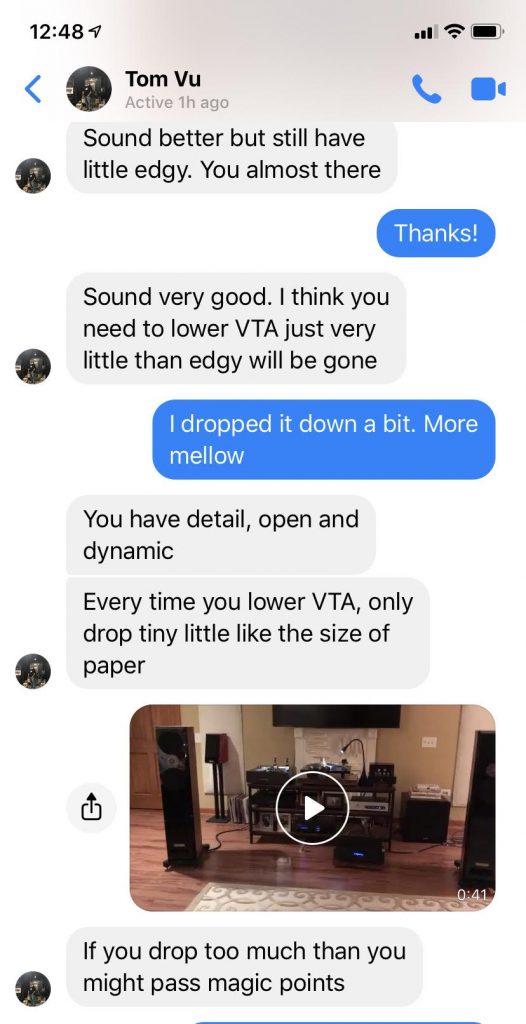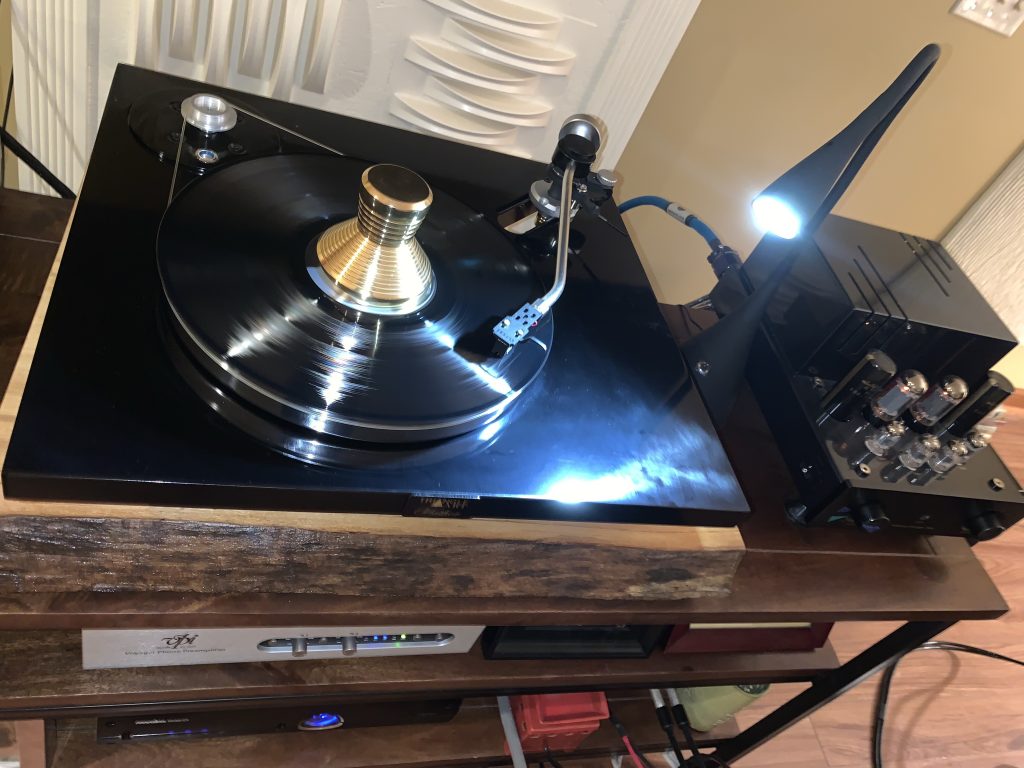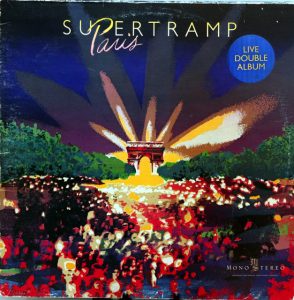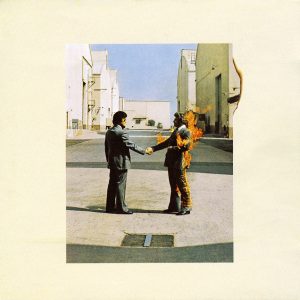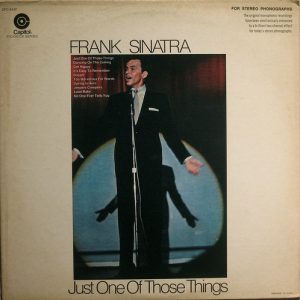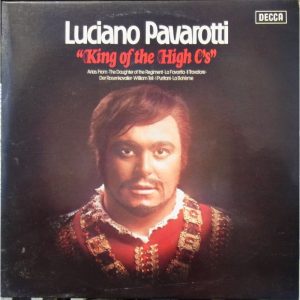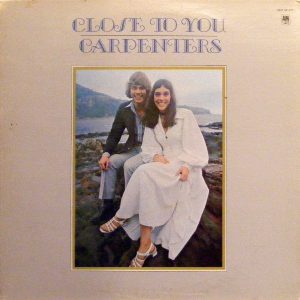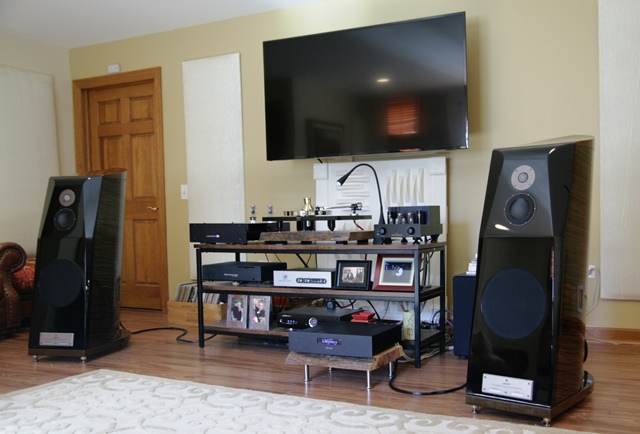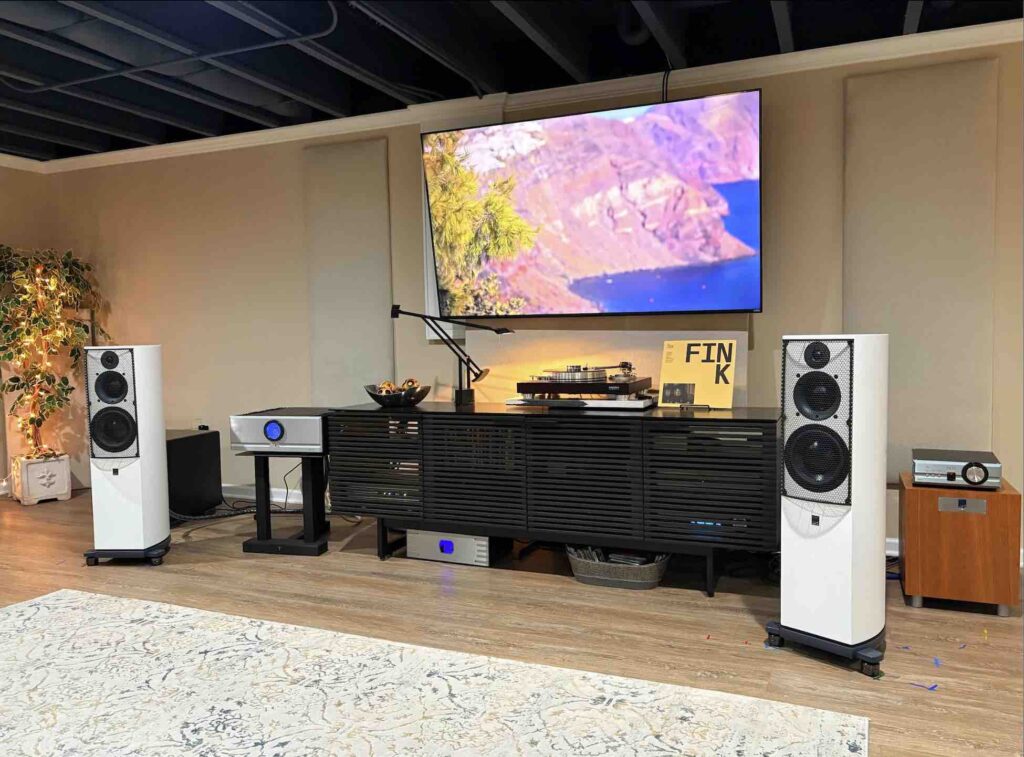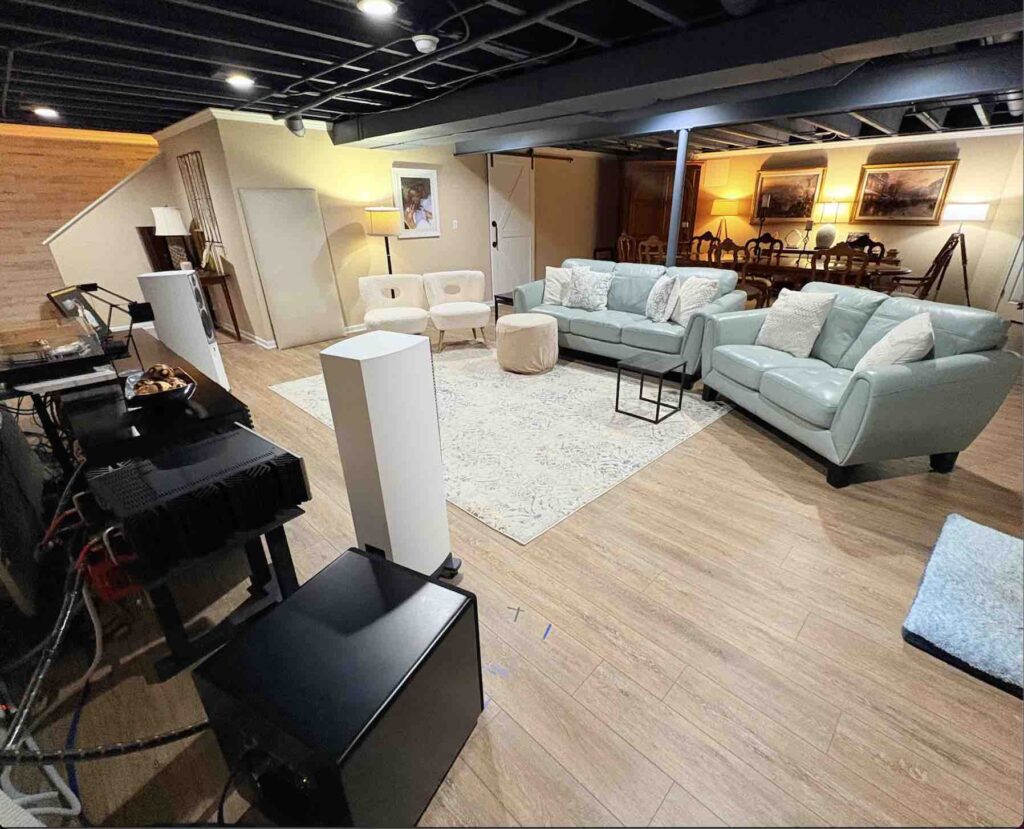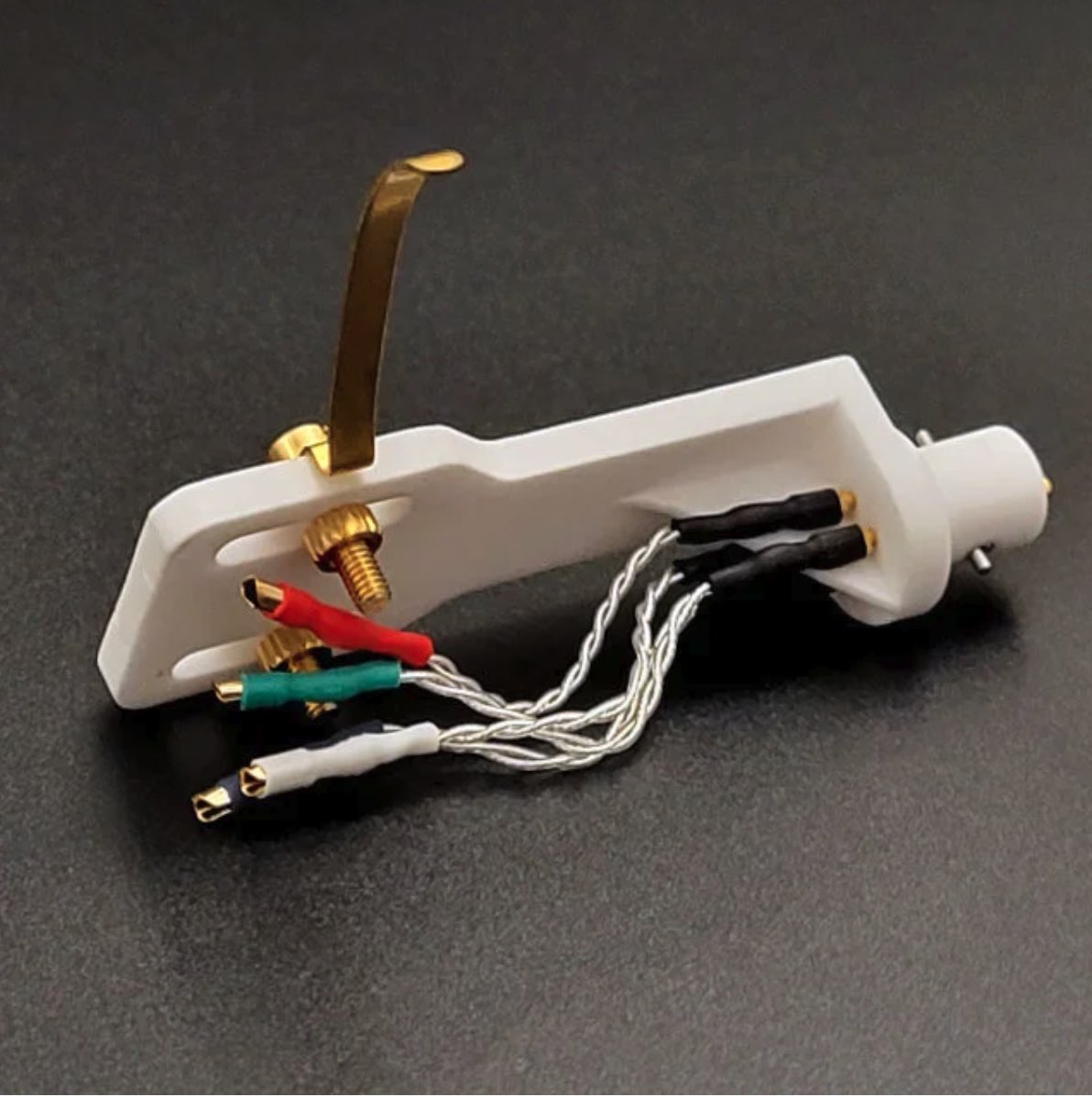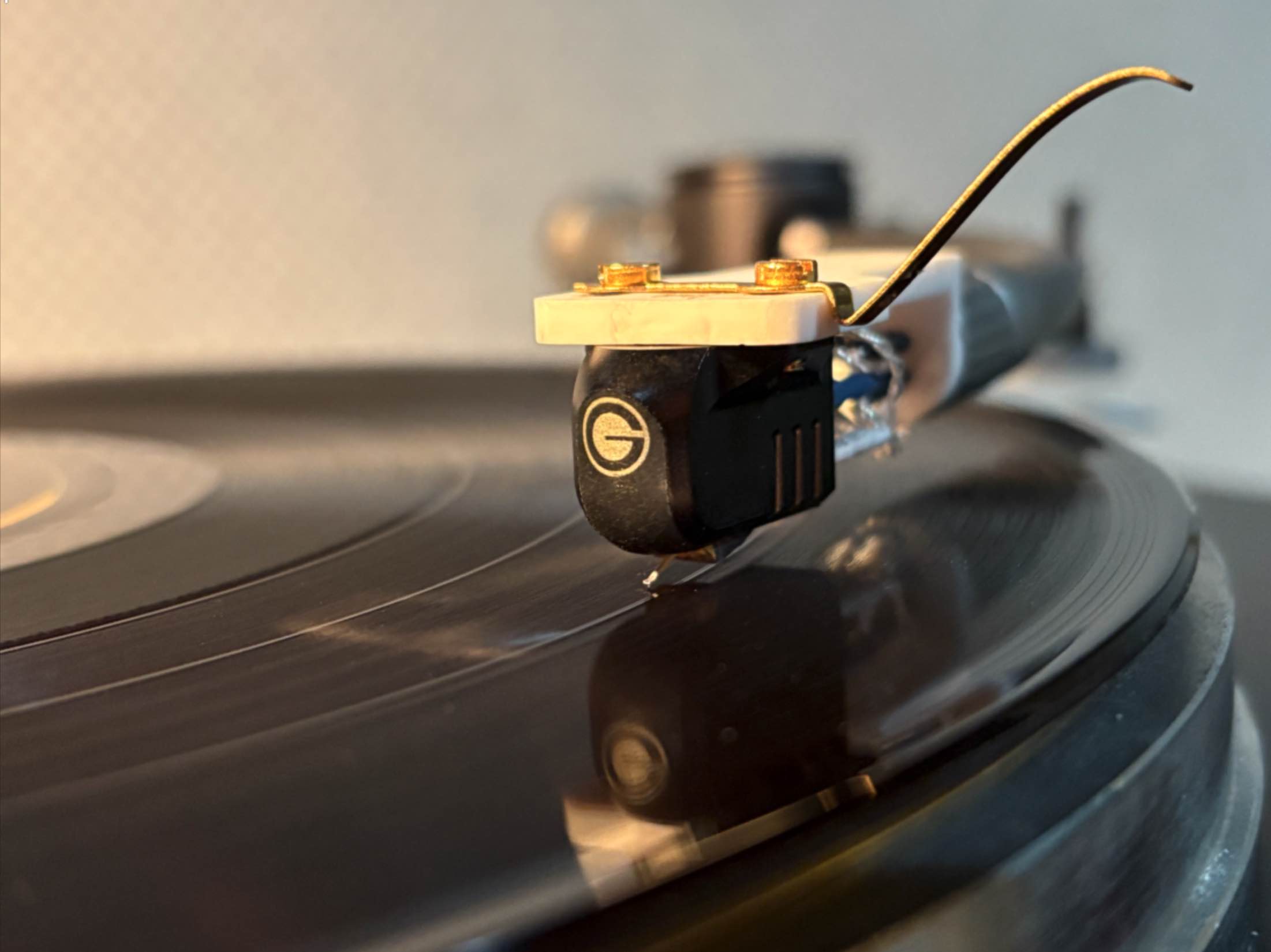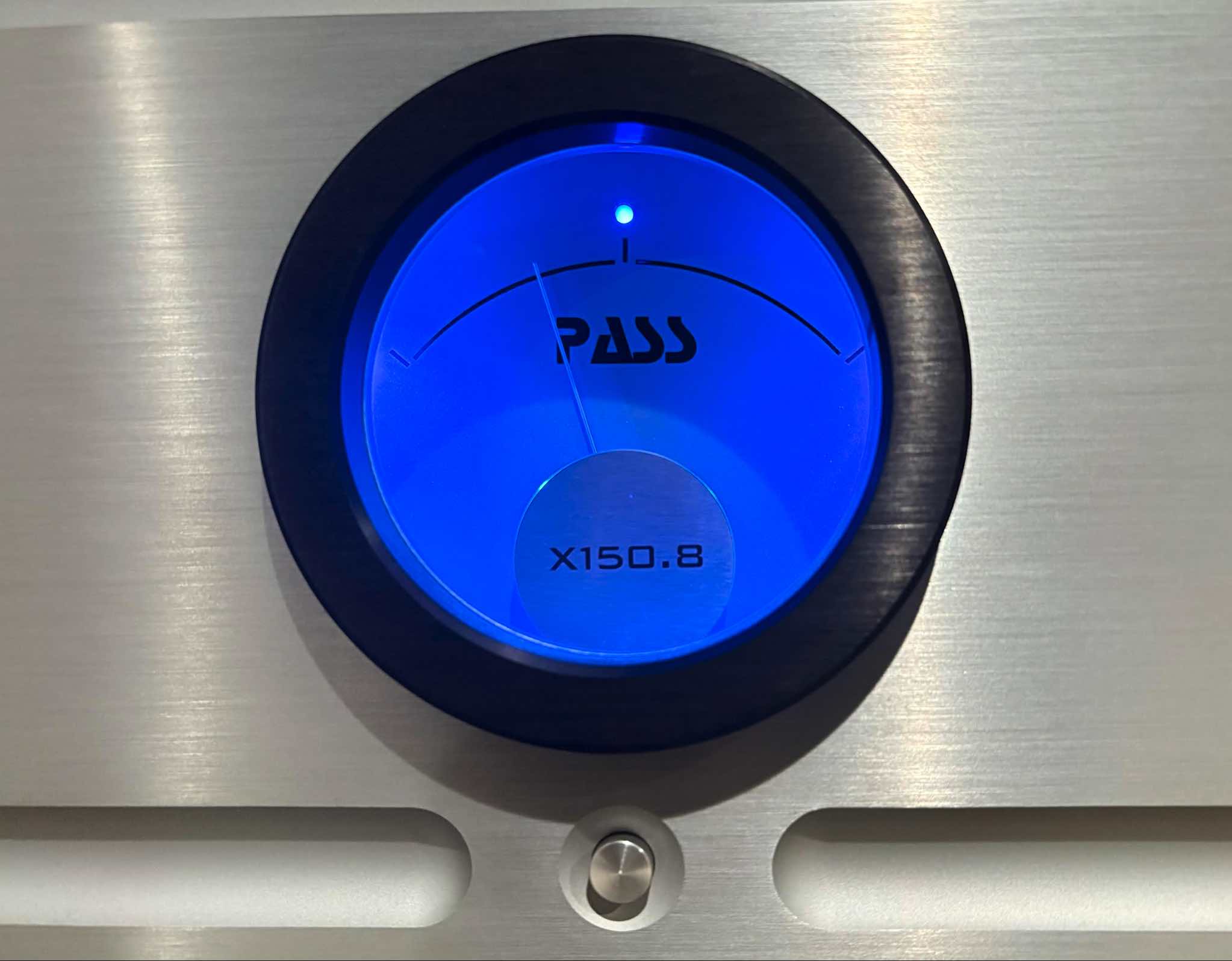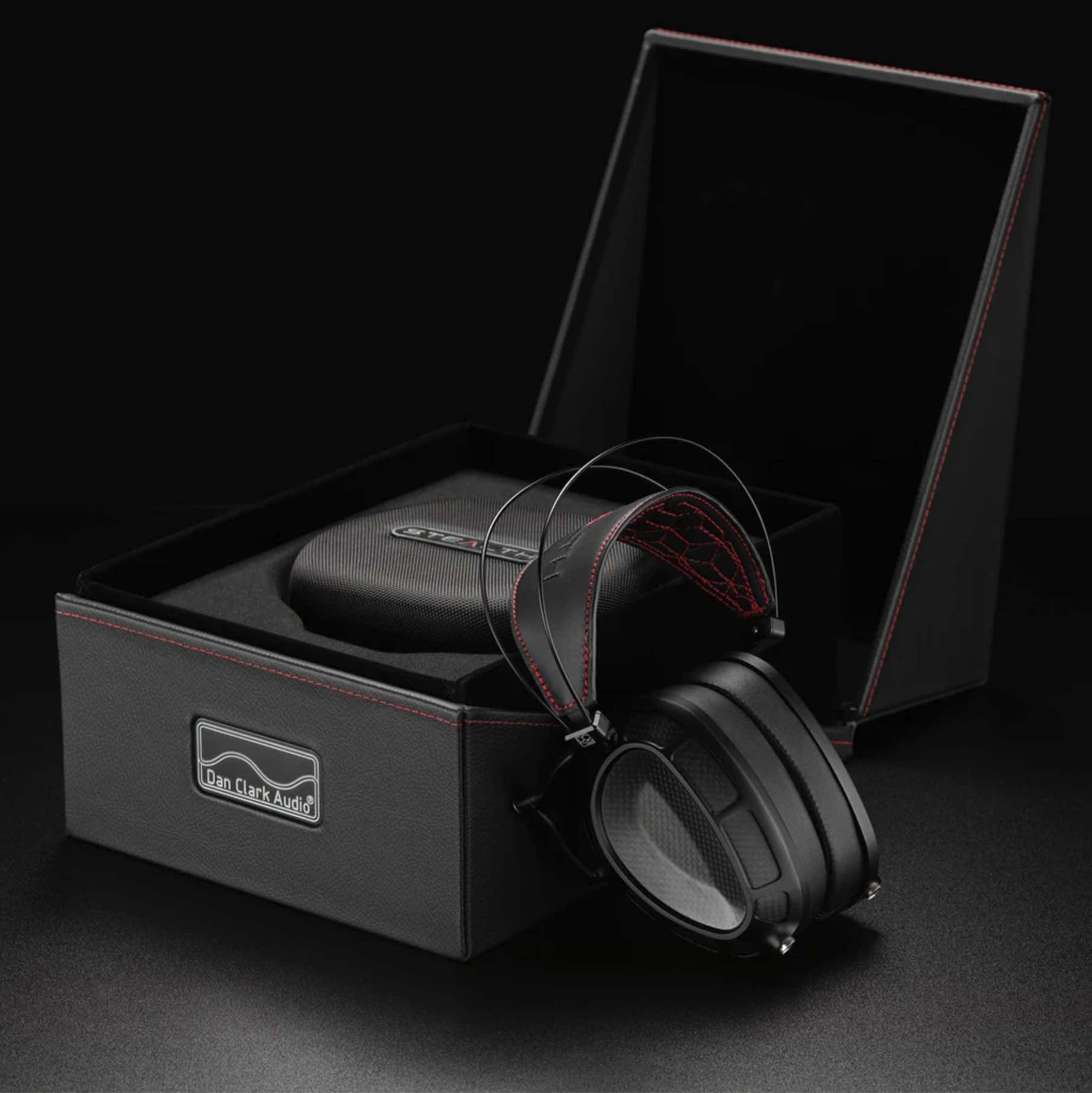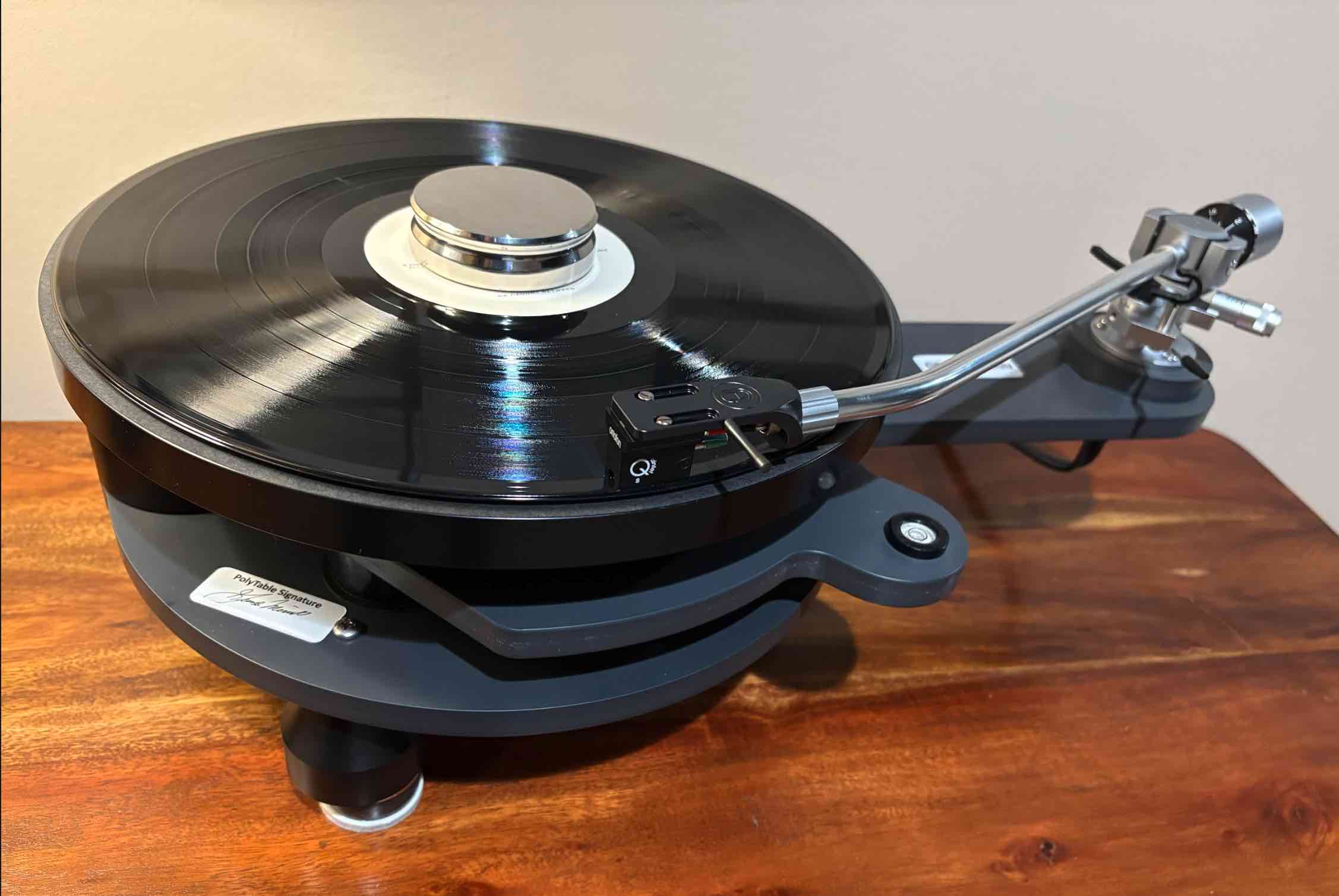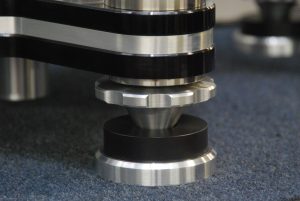The Triangle Art Hathor (courtesy of Triangle Art)
When sharing rack space with other electronics, the Hathor calls to mind actor George Clooney glamming the Golden Globes in his one button tux; understated and angular in black with gold and chrome accents, it's usually the head turner in pairings. But not only is it chic, it's also a terrific turntable.
The Hathor is the entry-level deck for Tom Vu's Triangle Art, a manufacturer based out of Anaheim, CA noted for their blingy signature turntables and electronics. At 60 lbs, it is hefty, but not nearly so as their $129,000 flagship, the 850 lb, sculpturesque, gold and chrome Ultimate Le 2 turntable which, like all their tables, employs a brass, copper, and stainless steel composite plinth for maximum sonic performance.
At $4000, the Hathor's price falls between VPI Industries' Prime Scout ($2000) and Prime Signature ($6000)—tables I've previously reviewed—and with its luscious aural presentation, it definitely holds its own.
Specifications
- Turntable material: composite alloys metal
- Custom synchronize AC motor
- Speed: 33.3 and 45
- Input voltage: 115V/60Hz or 240V/50Hz
- Platter: Chrome polished composite metal 1" thick
- Jelco TS-350L 12" tonearm and SA501 phono cable
- Dimensions: 7" H x 20" W x 18" D
- Weight: 60 lbs.
Setup
The Hathor arrives with its tonearm mount affixed to the plinth, and if you purchase a phono cartridge from Triangle Art, they will deliver it connected to the Jelco TS-350L tonearm for you (they also offer the option of having the tonearm assembly already dialed-in for simple plug and play). But even if you supply your own cartridge, there's not a lot of assembly involved.
Now for the squeamish or less handy, employing a professional to put it together is your best bet, however, if you have prior turntable setup experience, it's not too difficult.
Assembly instructions are printed in small font on one sheet, and include directions on drilling holes for the tonearm mount. Thankfully, that part is already completed. Overall, the directions are helpful, but a bit spare.
Care must be taken to not mar the surface where the Hathor sits, as it comes with three spiked feet, as well as nickel spike protection discs. The chassis is lowered over the belt drive motor with the circular opening directly above, fitting snugly into place. The power cord plugs into the lower rear of the motor.
Using both hands, slowly lower the platter onto the plinth, sliding its thick aluminum shaft into its receptacle and resting on a low drag thrust washer. Then, stretch the clear elastic drive belt from the motor's pulley around the platter, noting the pulley's settings; the narrower section is for 33 ⅓ RPM, while the wider section is for 45. Press the power button and the belt will automatically align itself.
Now for the Lampizator fans, if that button looks familiar, that's because it is the same one used on Lampizator DACs, only the Hathor's switch doesn't light up when pressed!
Placing the platter on the plinth is a snap, but mounting the tonearm's leads to the phono cartridge terminals—red to red, blue to blue, and white to white—takes care and time. The screws attaching the cartridge to the Jelco tonearm should remain a little loose to allow for adjustments later. As with my previous turntable reviews, I use the Ortofon Quintet Black S Moving Coil cartridge.
Simply slide the counterweight onto the Jelco tonearm assembly, then slip the bottom end into the tonearm plinth mount and attach the RCA and ground wire plug (the ground wire comes conveniently attached) underneath to secure it in place.
Using a digital stylus force gauge for feedback, the tonearm counterweight is adjusted by twisting it, then checking the weight. Getting it to the recommended weight for the cartridge can take time, so patience is required. Setting the anti-tracking dial is simple; Tom Vu advises to set it at zero.
Lateral Tracking Adjustment is a non-issue, as the tonearm does not flex laterally; it is fixed.
Now Adjusting the VTA (Vertical Tracking Alignment) is another matter; it is achieved by inserting an Allen Wrench into a screw on the side of the tonearm mount (hint: you have to look closely for it), loosening it to raise or lower the tonearm assembly and tightening to lock it in place.
As a starting point, the bottom of the cartridge should be parallel to the record's surface, and adjustments made from there, raising or lowering the tonearm level, locking it in place, lowering the stylus, playing and listening, raising and locking it, making minor VTA adjustments, and listening again.
Vu, who is in China on business during my review, requests photos and short video clips of playback on Facebook Messenger so he can assist me in real time. Listening and observing, he directs me to raise the height of the tonearm; listened to subsequent clips, he asks me lower, then raise the VTA settings in various increments. We listen to jazz instrumentals and female vocals, repeating the process a half dozen times until we arrive at a satisfactory setting. Collaborating on VTA adjustments from two different continents in real time is truly an extraordinary experience! The result is a detailed and lush, full-bodied aural presentation.
Playback
The Hathor's gold record weight is a rakish cap, adding a touch of panache but, more importantly, couples the vinyl to the platter, draining resonances away from the stylus. And like soft close cabinet drawers in an upscale home, the Jelco tonearm adds a touch of sophistication as it automatically eases the stylus down, protecting it from slamming into the vinyl. Too much coffee or jittery hands? Not a problem!
When the crowd fades in and, moments later, Supertramp's Rick Davies' signature harmonica ushers in a pristine live rendering of "School" on Supertramp's Paris, you know you're in for an aural treat. Bob Siebenburg's cymbals and snares, John Helliwell's sax, Roger Hodgson's guitar, keys, and vocals shimmer in real space. The Hathor renders reference live recordings well.
It also delivers a lush textural treat as Richard Wrights' synthesizer, David Gilmour's Fender Stratocaster, Nick Mason's drums, and Dick Parry's sax take turns enveloping the room room in "Shine On You Crazy Diamond" on Pink Floyd's Wish You Were Here. And the timbre and range of Roger Waters' vocals? At once powerful and delicate—forget about it! The overall presentation is rich, full, and nuanced.
The Hathor wrings out every last drop of magic of Frank Sinatra's rich baritone in its prime; accompanied by a bank of saxophones, upright acoustic bass, and brushed drums, it shines richly and true in the swinging title track of Just One of Those Things.
The strings, and woodwinds, the orchestra as a whole, reverberate in the hall—now your listening room—the Hathor delivers Pavarotti's seraphic and dynamic tenor in all its virtuosity and passion on "La Fille du Regiment" in King of the High C's. Delivered with authority and accuracy, even for someone not a fan of opera, it's a mesmerizing experience.
And if it's the female voice you like, the Hathor captures the warmth and unique, soothing timbre and harmonic signature of Karen Carpenter's vocals in the title track of the Carpenters' Close to You rapt with tenderness and emotion, entreating you to several listens of this timeless classic.
Concluding Remarks
The Hathor looks fabulous and plays well, rendering the vinyl experience in all its warmth with accuracy, depth and authority. At $4000, you can indulge in high end playback sans the huge price tag. Matched with good speakers, electronics, and cabling, you have the makings of many magical moments to come. And what's not to like about that?
Hathor Turntable
Retail: $4000
Triangle Art




